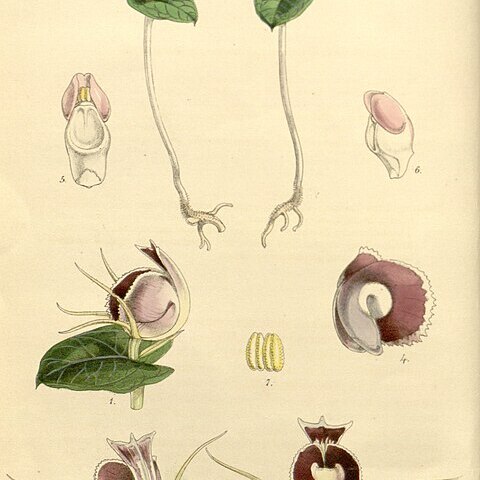Small, deciduous, terrestrial orchids with a single, ground-hugging, basal leaf that arises from a small, rounded tuber. Reproduction is from seed and local spread is by daughter tubers produced on the end of long, slender, fleshy stolonoid roots resulting in clonal colonies ranging from sparse, with widely scattered individuals, to spreading, congested groups. Flowering plants usually have a single flower which appears to squat in the base of the leaf. The flowers are unusual in that they are dominated by the dorsal sepal and labellum which together form a fungus-like structure. The base of the labellum is a narrow, curved tube and combines with the hooded dorsal sepal to completely enclose the small column. The main part of the labellum expands into a broad blade which is open to the atmosphere and is adorned with papillae and often has a conspicuous, mounded central area known as a boss. Lateral sepals and petals are either greatly reduced in size or appear as filamentous vestiges. Column short, almost as wide as long; in some groups with a swollen ventral pad. Pollinarium consists of 4 pollinia attached directly to a sticky viscidium.
Fls solitary, occ. 2; floral bracts us. 2, one minute, the larger us. shorter than ovary. Per. often large for size of plant; dorsal sepal uppermost, curved forward, ± concave to galeate; lateral sepals and petals linear to filiform, greatly elongate to extremely small. Labellum relatively large, the basal edges overlapping behind the column to form a tube, the distal part ± cylindric or expanded into a broad, abruptly deflexed lamina; margin entire, denticulate or fimbriate; calli if present minute and papillose. Column short, ± curved, us. inclined backwards, wings occ. represented by small lobes near top; anther terminal, erect, pollinia 2 per cell, pollen finely granular; stigma discoid, surrounded below by a fleshy ridge; rostellum median. Plants terrestrial, glab.; tubers orbicular, us. terminal on long laterals arising in axils of scale lvs on buried part of stem. Fl.-stem short, elongating greatly as fr. matures. Green lf solitary, broad, lamina us. horizontal. About 50 spp. from south-east Asia to N.Z., the 8 N.Z. spp. including 2 known also from Australia.

